The Monitor of Well-being and the Sustainable Development Goals 2022 has revealed that people with migration backgrounds and those with a low level of education have the lowest levels of well-being in the Netherlands.
Well-being, which includes more than just income, such as health, trust, quality of the living environment, and job situation, is lower among those that have a non-western migration background, with 13 factors indicating so.
According to the report, the thirteen indicators attributed to well-being (in terms of satisfaction with life) include material well-being, health, labour and leisure time, housing, society, safety, and the environment.
Furthermore, only eight of the indicators are found among people with a western background. The group with no migration background has not one unfavorable outcome and favourable outcome for twelve of the thirteen indicators.
“The often-unfavourable situation of people with a migration background is only partly caused by differences in the group’s education level, age composition, or male to female ratio compared with the group with no migration background,” the report explains.
People with lower levels of education had low points for nine of the thirteen indicators. This compares to just two out of the thirteen indicators below average for people with higher education.
In terms of sexes, 27.4 per cent of men had better results for well-being compared to women, which were 3.5 percentage points below. As per lower levels of well-being, women stood below men by 0.5 per cent, scoring 18.5 percentage points. The majority of those standing in the middle were women (57.6 per cent) compared to men (54.6 per cent).
As per migration background, native Dutch respondents had fewer negative indicators of well-being, with 15.7 per cent of them standing in the lower levels and 28 per cent standing on the top, which also marks the highest share in the group. In the middle level, which represents those with equally negative and positive indicators of well-being, the lowest share is recorded by non-western background respondents (53.1 per cent), indicating that respondents were either on the better scale of well-being or the very worst.
Among those with a Western background, 19.7 per cent had lower indicators of well-being, and 22 per cent of respondents were on the positive side, showing more positive indicators of happiness than the rest.
However, these rates were the lowest for respondents with a non-western background, as only 13.6 per cent had a positive outcome on the matter, while the share for negative indicators was the highest (33.4 per cent).
Only 10.1 per cent of those with a low level of education had a positive outcome, with 58.1 per cent being in the middle and 31.9 per cent having the lowest well-being indicators, which at the same time marks the record.
On the other hand, those with higher indicators of happiness were those with high education (38.9 per cent), and 10.2 per cent of those with higher education had negative indicators of well-being, SchengenVisaInfo.com reports.















